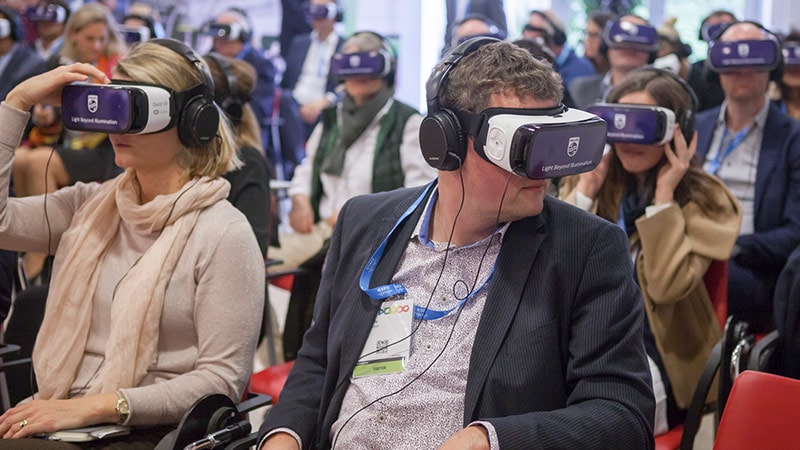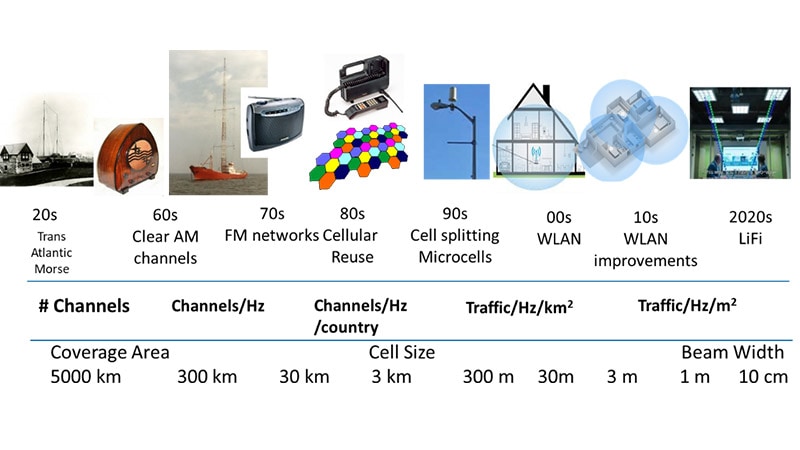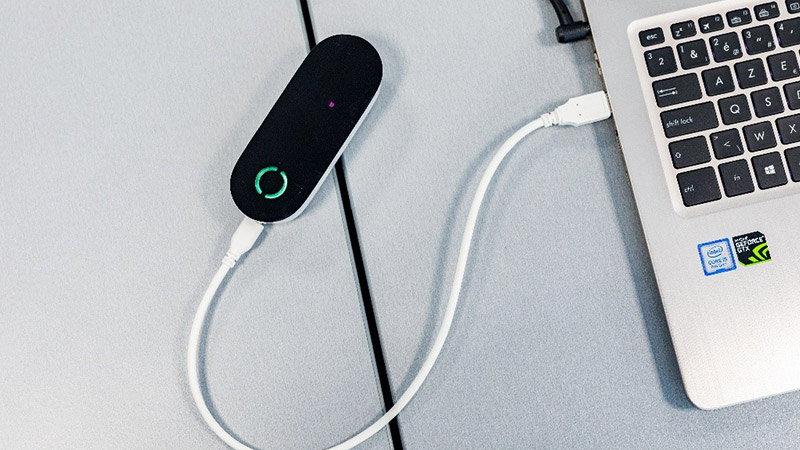November 13, 2019
Professor Jean-Paul Linnartz explores whether, after 125 years of innovation in radio technology, a transition to LiFi is the easiest way to overcome today’s communication challenges
The demand for communication is growing as thousands of radio researchers try to solve the current spectrum crunch that limits radio systems. But is a transition to optical communication the solution?
Signify’s Trulifi technology is a new series of Light-Fidelity (LiFi) products that communicate via light instead of via radio waves. It’s cool to see LEDs that not only illuminate but which also carry information. In fact, it’s not just cool: it’s becoming necessary.

The amount of data that we exchange wirelessly continues to grow much faster than Moore’s law. According to Gordon Moore, co-founder of Intel, the number of transistors in a dense integrated circuit doubles each year.
And not only do such chips now process richer data, today’s users spend more time at their devices and run more apps. As the number of connected people and devices mushroom, it’s hardly surprising that radio links are straining under increasing pressure to carry all this data traffic.
The transition from radio-based communication, such as WiFi, to LiFi, is the logical consequence of a long-lasting trend of data intensification in wireless communication.
The step towards light-wave systems, with their well-defined coverage, fulfills the growing need and demands for higher bit rates and interference-free, rock-solid connections.
The growth of wireless communication is often described as a trend that started in the last decade or two, but a deeper investigation reveals that the trend-lines are exponential, ever since Marconi sent his Morse code across the Atlantic.
While the use of radio waves was initially a privilege for broadcasters, and for the military to communicate with airplanes and ships, today it’s an everyday necessity. Many teenagers would rather spend a day without food than a day without WiFi!
The pace of technological change has been relentless. Early cell phones could only exchange text (SMS) messages of 160 characters, but today four and a half million YouTube videos are consumed every minute, many of them on mobile devices.
Trendwatchers identify Ultra High Definition TV and 3D-video as drivers spurring on the insatiable demand for communication and bandwidth. While virtual reality games, with instant interaction, will become widespread, higher resolution picture quality may lose its role as the only driver for higher video bit rates, as we have already attained impressive quality.
But in gaming, low latency is demanded to bypass even the slightest delays of a few milliseconds. Ever higher bit rates are needed to carry uncompressed, latency-free video.

Radio communication has accommodated this growth in several ways. One is the use of higher and higher frequencies where more bandwidth is available. Another is denser reuse of available frequency in different locations to maximize efficiency.
Remarkably, Marconi sent his message 5,000 km across the Atlantic Ocean. Luckily, he also had a clear channel; he was the only one using the airwaves. Radio no longer needs to cover large distances. Today our systems communicate wirelessly over shorter and shorter distances and a global fiber backbone effectively carries long-haul communication traffic between continents.
The days when medium- and shortwave radio was needed for its huge coverage are long gone. Its heyday was the 1960s when powerful transmitters reached out with 1.3 Megawatts to listeners over a 500 km radius. Then, stations such as Radio Luxembourg were household names. Using the same frequency twice in neighboring countries wasn’t a goal.
Philips sold radio sets across Europe with the same international names of radio stations on the dial in multiple countries. But AM radio severely limited the variety of programs people could listen to.
FM radio densified the reuse of frequencies, allowing different nations to use the same channel. It was a first example of optimizing for density, not for coverage, with each FM transmitter rarely covering more than 100 km, to allow reuse in nearby regions.



Unless increased demand suddenly halts after 125 years of exponential growth, we need breakthroughs. Radio systems are now under extreme pressure. This is down to the two key performance indicators for wireless communication systems
1) the maximum bit rate they can support
2)the density of users they can serve. LiFi is perfectly positioned to satisfy these demands.

In this respect, optical communication offers exactly what 5G communication tries to achieve via radio emissions: ultra-dense reuse, high bandwidth, low latency and the ability to connect IoT devices. While this is a stretch for radio communications, these requirements fit very well with LiFi.
The light spectrum offers a wealth of frequency space, which is unlicensed and free to use. The visible spectrum (400 to 700nm) offers no less than 320 THz of bandwidth, and the near-infrared spectrum, used for fiber-optic communication (1500 to 1600nm), offers 12.5 THz of bandwidth.
Spatial confinement of light to narrow beams, combined with huge bandwidths, will enable the creation of a dense grid of independent (‘atto’) cells. This effectively multiplies this huge bandwidth.
Combined with large spatial reuse, it offers the potential to deliver unrivalled wireless communication capacity. LiFi will do this relatively simply and is highly energy efficient as well.
What makes LiFi stand out is the ability to not just deliver great quality light but also gigabits per second per user. And more importantly, to repeat this bandwidth for many users, even in close vicinity to each other.
For me, LiFi isn’t an isolated technological curiosity. It comes as a logical next step in wireless communication. It’s the next phase to shrink cell sizes to the scale of a single room or smaller, as the TruLifi system by Signify does today. Meanwhile, at Research we’re looking ahead, to make the beam narrower and to shrink the cells to a square foot, or smaller.
Signify (Euronext: LIGHT) is the world leader in lighting for professionals, consumers and the Internet of Things. Our Philips products, Interact systems and data-enabled services, deliver business value and transform life in homes, buildings and public spaces. In 2023, we had sales of EUR 6.7 billion, approximately 32,000 employees and a presence in over 70 countries. We unlock the extraordinary potential of light for brighter lives and a better world. We have been in the Dow Jones Sustainability World Index since our IPO for seven consecutive years and have achieved the EcoVadis Platinum rating for four consecutive years, placing Signify in the top one percent of companies assessed. News from Signify can be found in the Newsroom, on X, LinkedIn and Instagram. Information for investors is located on the Investor Relations page.


December 17, 2024
Transforming Dubai’s iconic buildings with connected lighting from Signify